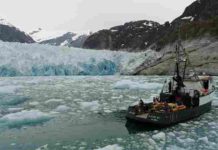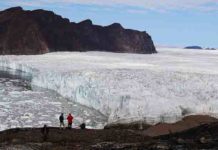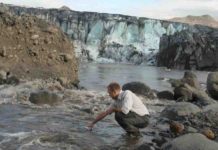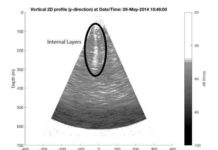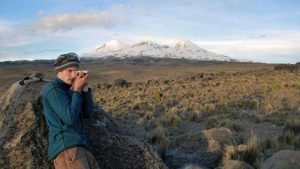
Many thousands of years ago, as the world slowly began to thaw at the end of the last ice age, the landscapes of southern Peru were quite different than the ones University of Maine’s Gordon Bromley finds himself wandering about these days.
Large domes of ice, blanketing the high and jagged peaks of ancient cordilleras, spilled down through steep Andean valleys like giant rivers of ice and carved across the high-altitude plateaus.
Today, these once grand ice formations are all but gone, yet the geological echoes of the last great global glaciation still remain.
When Bromley, a research assistant professor in the School of Earth and Climate Sciences and Climate Change Institute, looks out over the wide and barren vistas of the Peruvian altiplano, he reads the landscape like a long-lost tome recording the story of our planet’s ice-age past.
Bromley is a glacial geologist working to understand the chronology of late-Quaternary glacial events in the remote Andes of southern Peru.
In a new paper published in the journal Quaternary Science Reviews, Bromley and a research team present a new glacial chronology from two ancient moraine systems in southern Peru.
The paper reports the results of a seven-year interdisciplinary project that included researchers from the University of Maine, Columbia University’s Lamont-Doherty Earth Observatory, Pacific Lutheran University and Dartmouth College.
The new chronologies suggests that the glaciers of the southern Peruvian Andes reached their maximum extent between 28,000 and 26,000 years ago—earlier than the last glacial maximum (LGM) is recognized in other parts of the globe—and about 19,000 years ago they began their final recession with a very brief period of advance 16,100 thousand years ago.
Tropical glaciers are particularly sensitive to changes in climate and, like many other glaciers around the world, have undergone series of major retreats and minor advances since the LGM. However, the role the ocean and atmosphere play in this ebb and flow are far less understood. This is the overarching question Bromley and his team hope to address.
While few equate glaciers with the tropics, Bromley is particularly interested in what the glaciers of these areas and the landforms they’ve left behind can tell us about the dynamics of the global climate system as the world began to warm after its near 100,000-year-long hibernation during the last ice age.
Glacial geologists, like Bromley, use moraines to study long-vanished glaciers. Moraines are relics of the ice’s movement and spatial extent. Just as bulldozers push material forward and aside as they move through construction debris, advancing glaciers transport soil and rocks as they slowly scrape across the landscape. When they recede, this material is left behind in distinctive patterns and piles called moraines.
Bromley and the researchers use a geochemical technique called cosmogenic surface-exposure dating to ascertain exactly when each moraine was formed. As glaciers retreat, the surfaces of rocks, which had been frozen in ice for millennia, are uncovered and newly exposed to the sky and the flux of cosmic radiation.
Born from distant supernova, cosmic rays hurtle through space at near the speed of light until they enter Earth’s atmosphere and collide with the freshly exposed boulders. And while these particles glide through our bodies on a near constant basis, they interact with the quartz inside the rocks, blasting apart oxygen and silicon atoms, creating the rare isotope beryllium-10. Over time the amount of the isotope builds up inside the rock which compose each moraine.
By measuring the amount of beryllium-10 in a sample of the exposed moraine boulder, geoscientists like Bromley can determine precisely when it was abandoned on the landscape by a receding glacier.
In the Cordillera Carabaya, a subrange of the East Andes in far southern Peru, approximately 75 miles from the Bolivian border and at an altitude straddling 15,000 feet, Bromley and his team surveyed and sampled the complex moraine systems from two remote valley systems.
Surface exposure data garnered from the moraines in this region provided great insight into the glacial dynamics of the southern Peruvian Andes.
The results suggest that the atmosphere in the tropics warmed quickly at the end of the last ice age and that this warming appears to be in step with changes in the tropical Pacific Ocean.
“I think we have an impression now that the tropical climate is extremely sensitive, it dominates global climate and its extremely dynamic,” says Bromley.
Bromley and the research team suggest that a warm sea surface temperature (SST) anomaly the Equatorial Pacific, which persisted for nearly 3,000 years, as well as a southward displacement of the Inter Tropical Convergence Zone potentially played a key role in this reversal.
Similar to a modern El Nino event, changes in ocean and atmospheric circulation in the tropical Pacific may have allowed for the extended expansion of the Pacific Warm Pool.
The warm pool is an area of particularly warm ocean generally confined to the waters surrounding Indonesia. However with the breakdown of the influx of cooler waters into the eastern Pacific and a weakening of the offshore winds of South America, the warm pool is allowed to reach its full potential and expands to the length of the equatorial Pacific.
“As the energetic powerhouse of the globe, the tropics are the principal source of heat energy and water vapor for the climate system and thus represent a fundamental and dynamic component of global climate,” says Bromley.
When the Pacific warm pool expands, it drastically increases convection and brings large amounts of warm moist air high into the troposphere where it affects these high altitude tropical glaciers.
“The tropical atmosphere seems to be set by the Pacific Ocean as a whole,” says Bromley. “And the warming of the tropical Pacific has a rapid and global effect throughout the atmosphere.”
Like a global thermostat the tropical atmosphere sets the tone for the general temperature throughout the globe. As the tropics warm as a result of the growth of warm SST anomalies in the Pacific, so do global temperatures.
This type of atmospheric heating on a smaller scale was seen during the last and particularly strong El Nino event and contributed to the record-setting average global temperatures of 2015 and 2016.
The rapid decline of glaciers throughout the tropics may herald the very beginnings of the atmospheric change that drove global deglaciation at the end of the last ice age.
In addition to SST anomalies in the Pacific Ocean, the team is also investigating how the tropical temperature record aligns with atmospheric carbon dioxide concentrations to determine the greenhouse gas’s role in the termination of these tropical glaciers.
The team suggests that other high resolution moraine records like the one presented in this study are needed to further understand the variability of the tropical atmosphere and its implication on both past, and present, global climates.
Note: The above post is reprinted from materials provided by University of Maine.


